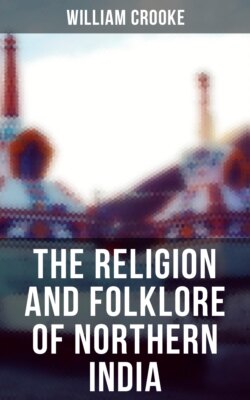Читать книгу The Religion and Folklore of Northern India - William Crooke - Страница 15
На сайте Литреса книга снята с продажи.
Eclipses and the Fire Sacrifice.
ОглавлениеTable of Contents
Hindus, like other primitive races, have their eclipse demons. “When once the practice of bringing down the moon had become familiar to the primitive Greek, who saw it done at sacred marriages and other rites, he was provided with an explanation of lunar eclipses; some other fellow was bringing down the moon for his private ends. And at the present day in Greece the proper way to stop a lunar eclipse is to call out ‘I see you!’ and thus make the worker of this deed of darkness desist. So completely did this theory, which we must regard as peculiarly Greek, establish itself in ancient Greece, that strange to say, not a trace of the earlier primitive theory, according to which some monster swallows the eclipsed moon, is to be found in classical Greek literature, unless the beating of metal instruments to frighten away the monster be a survival of the primitive practice.”43
In India, however, this earlier explanation of the phenomena of eclipses flourishes in full vigour. The eclipse demon, Râhu, whose name means “the looser” or “the seizer,” was one of the Asuras or demons. When the gods produced the Amrita, or nectar, from the churned ocean, he disguised himself like one of them and drank a portion of it. The sun and moon detected his fraud and informed Vishnu, who severed the head and two of the arms of Râhu from the trunk. The portion of nectar which he had drunk secured his immortality; the head and tail were transferred to the solar sphere, the head wreaking its vengeance on the sun and moon by occasionally swallowing them, while the tail, under the name of Ketu, gave birth to a numerous progeny of comets and fiery meteors. By another legend Ketu was turned into the demon Sainhikeya and the Arunah Ketavah or “Red apparitions,” which often appear in the older folk-lore.
Ketu nowadays is only a vague demon of disease, and Râhu too has suffered a grievous degradation. He is now the special godling of the Dusâdhs and Dhângars, two menial tribes found in the Eastern districts of the North-Western Provinces. His worship is a kind of fire sacrifice. A ditch seven cubits long and one and a quarter cubits broad (both numbers of mystical significance) is dug and filled with burning faggots, which are allowed to smoulder into cinders. One of the tribal priests in a state of religious afflatus walks through the fire, into which some oil or butter is poured to make a sudden blaze. It is said that the sacred fire is harmless; but some admit that a certain preservative ointment is used by the performers. The worshippers insist on the priest coming in actual contact with the flames, and a case occurred some years ago in Gorakhpur when one of the priests was degraded on account of his perfunctory discharge of this sacred duty. The same rule applies to the priest who performs the rites at the lighting of the Holî fire. It is needless to say that similar rites prevail elsewhere, chiefly in Southern India.44
In connection with this rite of fire-walking they have another function in which a ladder is made of wooden sword-blades, up which the priest is compelled to climb, resting the soles of his feet on the edges of the weapons. When he reaches the top he decapitates a white cock which is tied to the summit of the ladder. This kind of victim is, as we have already seen, appropriate to propitiate the Sun godling, and there can be little doubt that the main object of this form of symbolical magic is to appease the deities which control the rain and harvests.
Brâhmans so far join in this low-caste worship as to perform the fire sacrifice (homa) near the trench where the ceremony is being performed. In Mirzapur one of the songs recited on this occasion runs: “O devotee! How many cubits long is the trench which thou hast dug? How many maunds of butter hast thou poured upon it that the fire billows rise in the air? Seven cubits long is the trench; seven maunds of firewood hast thou placed within it. One and a quarter maunds of firewood hast thou placed within it. One and a quarter maunds of butter hast thou poured into the trench that the fire billows rise to the sky.” All this is based on the idea that fire is a scarer of demons, a theory which widely prevails. The Romans made their flocks and herds pass through fire, over which they leaped themselves. In Ireland, when the St. John’s Eve fire has burnt low, “the young men strip to the waist and leap over or through the flames, and he who braves the greatest blaze is considered the victor over the powers of evil.”45
By a curious process of anthropomorphism, another legend makes Râh or Râhu, the Dusâdh godling, to have been not an eclipse demon, but the ghost of an ancient leader of the tribe who was killed in battle.46 A still grosser theory of eclipses is found in the belief held by the Ghasiyas of Mirzapur that the sun and moon once borrowed money from some of the Dom tribe and did not pay it back. Now in revenge a Dom occasionally devours them and vomits them up again when the eclipse is over.
